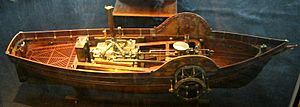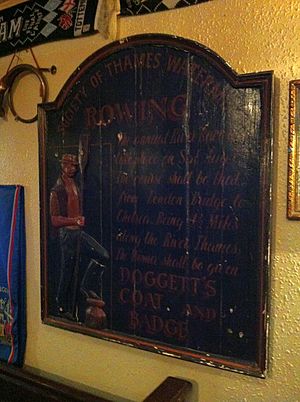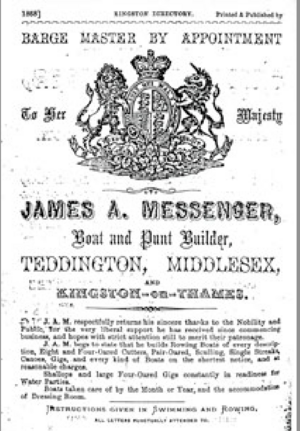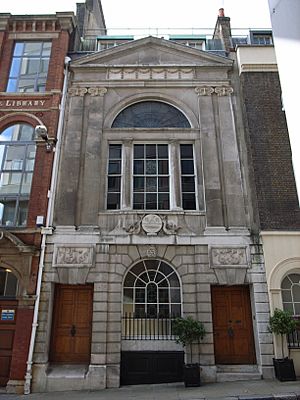Waterman (occupation) facts for kids
A waterman is a river worker who helps people travel across and along rivers and estuaries, especially in the United Kingdom. The most famous watermen worked on the River Thames and River Medway in England. Other rivers, like the River Tyne and River Dee, Wales, also had watermen who formed special groups called guilds long ago.
Watermen used to steer boats carrying passengers. These boats were often small rowing boats or boats with sails. Over time, watermen learned more skills. They became local guides, helped tie up ships at docks, and even steered large vessels.
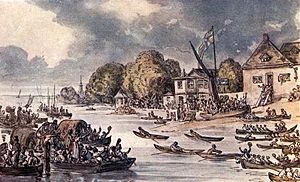
Contents
Watermen in the United Kingdom: A Look Back
How Watermen Helped London Grow (1197 to 1859)
Watermen, also called wherrymen, were very important in early London. They used small boats called wherrys or skiffs to carry people along and across the river. Roads were bad and city streets were crowded. So, the River Thames was the easiest way to travel in the area. For a long time, London Bridge was the only bridge over the Thames below Kingston upon Thames.
In 1197, King Richard I gave control of the Thames to the City of London. They tried to make boat owners get licenses. Later, in 1350, King Edward III passed a law to stop people from blocking the river. Things built into the river for fishing made it hard for boats to pass.
In 1510, King Henry VIII gave watermen special permission to carry passengers. This was like giving them a license for public transport. In 1545, Henry VIII even built special homes for watermen who were old or sick.
Rules and Training for Watermen
A law in 1555 officially set up the watermen's trade. It created a company to control prices and prevent accidents. This new company had power over all watermen working between Windsor and Gravesend. The London mayor and other leaders chose eight watermen each year to run the company. They made and enforced rules.
The law also said that watermen had to train for seven years. This was called an apprenticeship. During this time, they learned everything about the Thames, including its currents and tides. Watermen who were "freemen" (fully qualified) had to pay fees every three months. This often caused arguments, as some accused the company leaders of taking bribes.
In 1642, just before the English Civil War, watermen fought for a fairer way to run their company. They won the right to choose representatives from different towns. These representatives would then suggest who should lead the company. This system lasted for a while, but in 1827, a new law brought back an older, less fair way of governing.
Challenges for Watermen
London didn't have many bridges, and the land to the south and east was often wet and marshy. This made the Thames the main route for all kinds of travel. In the 15th and 16th centuries, the narrow arches of the Old London Bridge slowed the river's flow. This sometimes caused the Thames to freeze in winter, leading to fun frost fairs where people could walk across the ice!
In 1630, horse-drawn coaches and sedan chairs became popular. Also, many London theaters and parks moved from Bankside (south bank) to the north bank. This meant fewer people needed watermen, causing them financial trouble. The poet John Taylor, who was also a waterman, wrote about these hard times.
In 1635, watermen complained about the new horse-drawn hackney carriages. King Charles I even banned them for a short time, saying they made streets too crowded and dangerous. But he canceled the ban two years later.
During the English Civil War, watermen were not forced to join the army. This meant they could ask for higher pay from the navy. Samuel Pepys, who often traveled by water, wrote in his diary about his waterman dying during the Great Plague of London in 1665. This shows how dangerous it was to be a waterman during that time.
Changes on the River
In 1700, watermen joined with workers who moved cargo to form the Company of Watermen and Lightermen. The building of more bridges, like Westminster Bridge in 1750, changed river trade. Freight could now move along a river and canal system, connecting London to other parts of England. London became very rich because of its port, which relied on watermen and lightermen to move goods smoothly. This was a great time for moving goods by boat, and many made fortunes using the distinctive red-sailed Thames sailing barges.
In times of war, Thames watermen were often the first to be called upon to work on royal navy or merchant ships. They were skilled sailors. After the American War of 1812, many watermen decided to stay in the United States.
The arrival of steamboats in 1819 made the small wherry boats less useful for public transport. The large waves from steamers often rocked or even sank small wherries. This scared away potential passengers. The Woolwich Steam Packet Company started in 1834 and became a leading carrier.
Later, in the 1870s-1890s, railways grew, and more people used the river for fun. Villages outside London, like Maidenhead, became popular places to rent small boats for a day on the river.
Thames watermen played a big part in the early days of trade unionism in the UK. They used petitions to complain about problems, like the growth of hackney coaches. In 1644, the House of Commons even excused watermen from land service (joining land armies) because of their group's pressure.
Life was tough for watermen. There was no effective police force, and cities often had riots. Besides the risk of drowning, watermen often got lung diseases from working near the Thames. In the 1840s, the invention of the flush toilet turned the Thames into a giant sewer. This caused outbreaks of typhoid and cholera, and the terrible Great Stink of 1858. This led to a redesign of the city's sewage system in The Embankment area. This new design moved sewage away from the river but also removed the old Watermen's stairs and sloping paths to the river, replacing them with piers. This stopped flooding but cut off many riverside houses from boat access.
Watermen in the United Kingdom: Modern Times (1859 to 1999)
A law in 1859 took away many special rights from the Watermen's Company. It also created the Thames Conservancy, which shared responsibility for the Thames.
In 1871, the Labour Protection League helped lightermen get better deals from their employers. Writers like Charles Dickens studied river workers and wrote about their hard lives in books like Our Mutual Friend (1865) and an essay called Silent Highwaymen (1879). These writings helped people care more about social issues.
In 1878, the sinking of the Princess Alice ship, which killed 600 people, deeply shocked Victorian era society.
In 1889, watermen and lightermen joined the successful Great London Dock Strike. The Amalgamated Society of Watermen, Lightermen and Bargemen was quickly formed in 1893. It later joined the Transport and General Workers' Union in 1922. Many watermen used their barges to help the government during World War I. Moving coal and goods was very important during wartime. However, in the 1920s, bad conditions and strikes again stopped work at London's docks.
The British Tugowners Association started in 1934. This allowed watermen to use their skills, especially in tight spaces, in ports around the world. These skills have been used less recently because of new technology like bow thrusters.
In the late 1930s, fast boats were tested on the Thames. Some of these boats later became part of the Air Sea Rescue fleet, piloted by watermen during the 1940s. During the Normandy landings in 1944, 400 barges were used by the military.
Bombing during the Blitz in World War II badly damaged the docks. By the 1960s, new container technology and moving docks to Tilbury made the lightermen's job less important. Most up-river docks were abandoned by the 1980s.
Some watermen started river cruise companies in the late 1940s, encouraged by the Festival of Britain in 1951. Others started in the 1980s. By focusing on passenger comfort and offering night cruises, some companies have become very successful. In the lighterage business, Cory Environmental found a clever way to make money. They used their empty coal barges to transport rubbish from London's streets on return trips. This extra money allowed them to buy barges from smaller companies that were closing down. Between 1967 and 1976, over 40 lighterage companies shut down.
Watermen also had steady, well-paying jobs on the "Bovril Boats" during tough economic times. These boats had been taking London's sewage from Crossness and Beckton to the Thames Estuary since 1887. This continued until the 1990s, when new laws stopped dumping sewage at sea. This also matched a big change in how people thought about the environment. In 1999, Thames Clippers started a water-bus service for commuters in London. In 2003, the local government offered money to support this, seeing it as a greener way to travel. More people traveling by boat and more rubbish moved by lighter boats means less traffic on London's streets.
The Company of Watermen and Lightermen
The Company of Watermen and Lightermen is an old group that licenses Thames Watermen. Its old records of apprentices are very useful for people researching their family history. Even though it has old roots, it still works today to help its members. It works with the Passenger Boat Association and talks with the government about issues for its members. In 2003, the company used government money to help apprentices from east London boroughs like Tower Hamlets and Newham.
The Doggett's Coat and Badge race, which started in 1715, is the oldest river race that has run continuously. It is now said to be the oldest continuously held annual sporting event in the world.
In 1975, a charity called Transport On Water (TOW) was started by watermen and others. Its goal is to keep the Thames and other waterways, like the River Medway, working rivers. TOW has organized The Thames Barge Driving Race every June since 1974.
River Transport Today
More than 2,000 commuters now travel by river every day. In 2002, three million people traveled by river in total. Ken Livingstone's Transport Strategy for London (2005) said that the safe use of the Thames for passengers and goods should be developed. Passenger services would be encouraged, especially those related to London's culture and tourism. Using London's other waterways for goods would also be encouraged. Transport for London now has a special department, London River Services, to manage and promote river travel as a public transport service.
New Licensing Rules
New rules in 2007 created a national license system for all inland waterways. Instead of a five-year apprenticeship, people can now become a captain after two years of training plus six months of "local knowledge" training on the central Thames. This new license makes UK rules similar to EU licensing standards. Some people worried that it would make the Thames, which is a tidal river below Teddington lock, more dangerous. Under the old system, about 23% of apprentices failed their first year exam. It's thought that about 600 Watermen and Lightermen work on the Thames today.
| Date | Total Watermen working the Thames |
|---|---|
| 1628 | 2,453 |
| 1850 | 1,500 |
| 2006 | 600 |
Watermen Around the World
Watermen in Australia
The term "watermen" was also used for boatmen doing similar jobs in British colonies. This was true in Sydney Harbour and in Van Diemens Land (now Tasmania). Watermen worked on the River Derwent near Hobart and the River Tamar near Launceston.
Regular ferry services started on the Derwent by 1810. The first known licensed ferrymen were Urias Allender and John Nowland in 1816. By the 1830s, these ferrymen were called "watermen" in official records. This term was used until the last licensed watermen retired in the 1940s. The busiest time for Hobart's watermen was from the 1840s to the mid-1850s, when over 200 licenses were given out. But as steam ferry services improved, the numbers dropped. By 1896, only 21 watermen were licensed. At this point, they mostly offered water taxi and tour services.
Tasmanian watermen's boats varied a lot in size and style. They ranged from small dinghies for rent to large sailing-rowing tour boats about 28 feet long. The largest of these, the 28-foot Admiral built in 1865, was restored in 2006-09. It has been rowed at the Australian Wooden Boat Festival. It is the last known surviving 19th-century Tasmanian waterman's boat. In the 20th century, motorboats up to 15 meters long were licensed as waterman's boats. Today, about ten vessels offer tours out of Hobart, but none are in the old "hire boat" style of the watermen.
The main place for watermen in Hobart from the 1830s to the 1940s was Waterman's Dock. Licenses were also given to boatmen in other parts of south-eastern Tasmania, including Port Arthur.
Watermen in the United States
Some English sailors who fought in the American War of 1812 settled in the Chesapeake Bay area in the United States. They became watermen in small communities like Tangier Island and Smith Island in Virginia, and Tilghman Island, Maryland. These communities still have a unique character and way of speaking today.
The first Africans arrived in the Chesapeake Bay area in 1619. They and their descendants have played a role in the area's history and economy ever since. Enslaved Africans had skills in fishing, crabbing, sailing, and boat building from their homelands. Many used these skills in the Chesapeake Bay. In the centuries that followed, their descendants helped build the communities and culture around the Bay. Their work greatly helped the region's marine industries. The Bay's waterways were used for the slave trade, but also offered a way for enslaved people to escape to freedom.
African American watermen became expert fishermen in the Chesapeake Bay area. When steamboats arrived in the 19th century, many found work as river workers. Traditional white watermen often avoided the risks of early steamboats, like boiler explosions or fires.
African American watermen found financial success and freedom by specializing in crewing these boats in the Mississippi River Steamboat economy of the 1840s.
An article from the American Meteorological Society says that the village of Bellevue was founded in the early 1900s by African Americans working in the seafood industry. They shucked oysters, picked crabs, or worked as watermen. A seafood factory that hired and housed African Americans sold some land to them. By the 1930s, the Bellevue Seafood Company was owned and run by African Americans. Until the 1970s, many African American watermen worked in the same areas as white watermen, often on the same boats, and sold their catch to the same buyers, with little racial discrimination.
Famous Watermen
- James A. Messenger (1826-1901) was the Bargemaster to Queen Victoria from 1862 to 1901.
- John Taylor (1580–1653), known as the Water Poet.
- Robert Coombes (1808 – 25 February 1860), celebrated professional oarsman and Champion Sculler
See also
- Queen's Bargemaster
- Gondola
- Thames sailing barge
- London Bridge
- Thames Barrier
- 1928 Thames flood
- Bumboat
- Henry Mayhew
- William Lionel Wyllie
- George Robert Sims
- Edward William Cooke
- Swan Upping
- SS Richard Montgomery
- Watermen's stairs
- Foster Yeoman
- Cory Environmental
Images for kids


